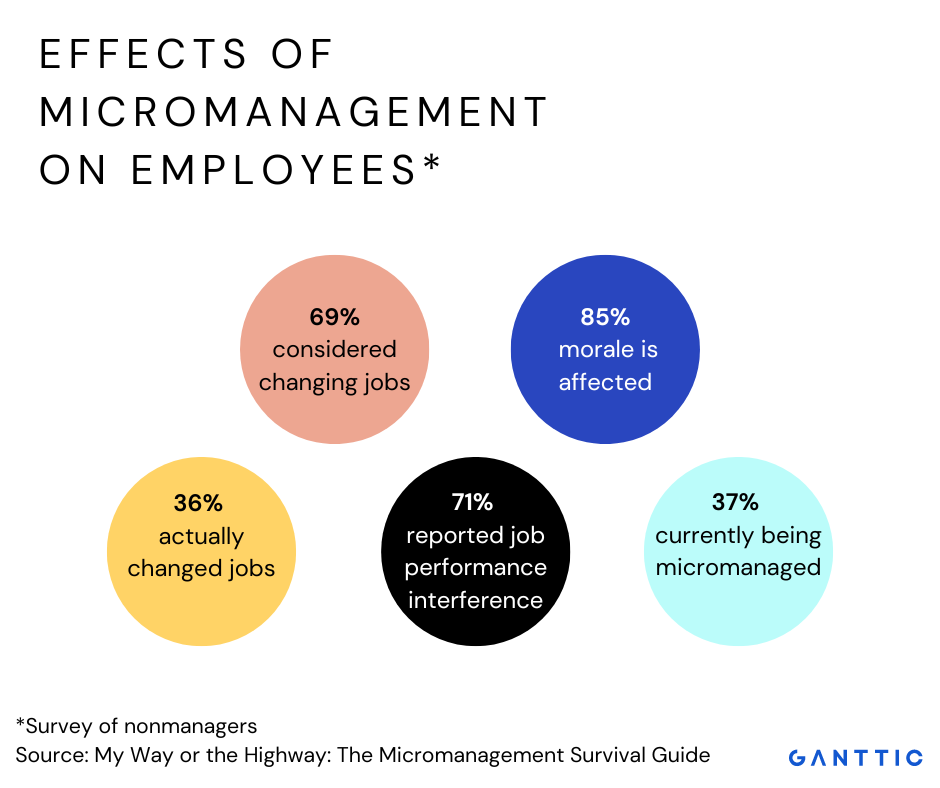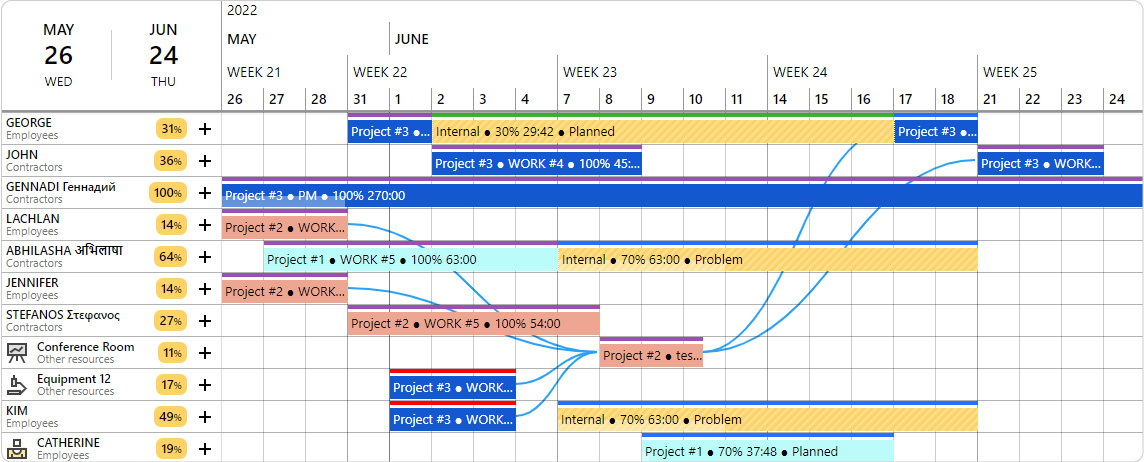As a project manager, you naturally want your team, and the projects you’re all working on, to become successful. To do that, you need to ensure that everything—from the budget to the timeline—is on track. However, when a project strategy is results-oriented, it often leads to micromanagement. Something that doesn’t always guarantee project success. And which certainly doesn’t endear you to your team. Discover some ways to achieve more effective project management, without the need to micromanage anyone.
What is Micromanagement?
Micromanagement refers to a “management style” where a leader closely monitors and controls every aspect of a project or work activity in an excessively detailed and often intrusive manner. This level of control seeps into daily activities. So much sometimes that it grinds work to an abrupt halt. Especially when the manager in question is involved in the day-to-day tasks and decisions that should typically be handled by team members.
Characteristics of a Micromanager
It’s not hard to spot a micromanager. And even if they have the best intentions, you will inevitably notice the following characteristics:
- Excessive control
- Incessant monitoring
- Overly detailed instructions
- Lack of trust
- Frequent changes and second-guessing
- Difficulty delegating
- Limited autonomy
- Bottlenecks for decision-making
- Negative impact on morale
- Missed focus on bigger picture
The Effects of Micromanagement
We all know that micromanagement isn’t a good thing. But just how bad is it?
According to a published survey, there are some major psychological and physiological effects that come with micromanagement. The study found that 71% of employees felt that micromanagement hindered their job performance. Meanwhile, 85% said that this management style was too hands-on and controlling. Finally, 36% of the micromanaged employees switched jobs because of damaged morale.

Moreover, micromanagement negatively affects morale, job performance, and engagement. Adding an extra layer of psychological effects like stressed team members, that they likely don’t need.
On the other hand, it is your responsibility to ensure that every detail in the project will flow smoothly. So, how do you strike the balance? Here are some productivity tips that promote effective management.
What Effective Project Managers Do Instead
Instead of relying on micromanagement techniques, the most successful project managers try these methods instead.
Learn the Strengths of their Team
You can establish trust within the workplace by having the confidence that the right tasks are assigned to the right individuals. Project managers must know the strengths and limitations of their employees. Having that knowledge allows them to empower individuals to take initiative and be accountable for their work.
Active listening and observing are just some of the practices for learning about your workers’ weaknesses and strengths. You can watch how they interact with each other and how they engage with the projects.
Now, if you want to get inside their heads, you can organize regular one-on-one meetings. You can ask them questions that reveal where they excel. Here are some examples:
- Where do you find yourself stuck in the project?
- What projects or tasks interest you?
- What areas are you interested in developing your skill set in?
By knowing more about your employees, you can ensure that the right people are handling the right tasks. What’s more, you’ll have the confidence that your team is working with professionalism and passion.
Allow People to Create a Plan for Success

One of the reasons why supervisors resort to micromanaging is because they feel like their employees work aimlessly. So, if you want success for your project, you should talk to your team and ask them to come up with a plan for reaching the company’s desired outcome.
This approach allows individuals to think through their goals and plans. As a manager, you will get insights into their planning, critical thinking, and coordinating skills. If you see problems with their plans, you can discuss how they can come up with better results.
You can also establish a backup plan that will correct their course in case their approach doesn’t work. Doing so will put you in a coaching role instead of a micromanaging position.
The plan should also include a timeline where you can check in and monitor progress. Indeed, the process uncovers challenges and helps you determine if they’re doing things according to a resource allocation plan. However, it can be an opportunity to assess results without micromanaging them.
Give People Space
It’s pretty obvious that if you want to promote productivity and effective management, you’ll need to give your team space. Even so, it’s natural for projects and businesses to have a system that requires micromanagement to some extent. After all, some tasks can only move forward after a manager gives their seal of approval. Moreover, some employees can only come to a conclusive answer when they discuss the details with you.
Of course, you’d want to stay ahead of what’s happening in the project. However, there’s a fine line between being the team’s project leader and being a big hindrance. As such, make sure there’s a clear discussion about where they need you and where they don’t. Give them space when they need it and learn to step back when you don’t have to be involved.
Now, if you want to keep track of your team’s productivity, there’s no need to hover over their backs. There’s plenty of tools to help that don’t feel intrusive. For example:
- You can use a timekeeping app that monitors activity levels and app usage. Tools like this should provide you with insights into how people spend their time during work hours. By looking at the productivity reports, you will get an overview of their progress without micromanaging them.
- Project resource management software gives an overview of project progress, while also illustrating what your team members are engaged in. Plus, with metrics that track milestones and project progress, you can see if everything is going according to plan.
- Use a mix of both! There’s plenty of ways to track time in your favorite resource planner – whether it’s manually or automatically. See which is most comfortable for you and your team.
Facilitate Coaching Sessions

Once you’ve established a plan for achieving project goals, you also need to facilitate regular check-ins. As we’ve mentioned, this approach will help you discover unresolved roadblocks. You can also encourage your team to discuss obstacles and challenges to allow a collaborative problem-solving effort.
As a manager, it is your duty to help them fine-tune the solutions they provide. Help them to broaden their perspective and give them the freedom to carve their own path. When you take the right approach, it won’t feel like you’re micromanaging them. Instead, they will look at your process as a supportive and caring partnership that aims to help people grow and produce great results.
Now, remember that these coaching sessions shouldn’t be all about problems. You should also take them as an opportunity to recognize an employee’s efforts and achievements. Acknowledge all the milestones they’ve reached and the challenges they’ve overcome.
Request for Leadership Feedback
According to business psychology professor Tomas Chamorro-Premuzic, 80% of managers think that they’re better leaders than they actually are. So, you may believe that you’re taking a great approach to managing a project, but your team may be thinking otherwise.
As such, if you want success for your project without micromanaging employees, ask for feedback. The coaching sessions should be an opportunity to get constructive criticism from both parties. You can ask them the following questions:
- What aspect of my leadership do you think I should improve on?
- Do you think I’m overlooking anything?
Encourage them to share their feedback and insights while reassuring them that there will be no consequences for honesty. Taking this approach will allow you to make management improvements that will support employees and bring your project towards success.
Want to find out if you’re as good of leader as you think you are? Take our leadership quiz and learn what areas you can improve upon.
Conclusion
It’s understandably challenging to manage people, especially if you’re managing a remote team. However, there are tools and resources available that will help you become an efficient leader without being too controlling of your employees. For a project to be successful, you also have to consider the wellbeing of the people behind it.

Incorporating resource management strategies into your normal project workflow can help you strike the right balance without the need for micromanagement. Pairing those with project management software that lets you concentrate on both resources and projects separately can transform you into the leader you were born to be.
Take a tour and see what Ganttic can do for you. Or sign up for a free demo and we’ll introduce you to a more effective way to manage projects.